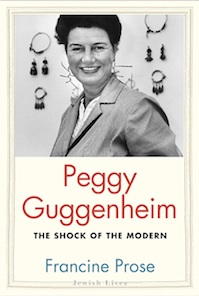By Svetlana Alpers
This is a smart and entertaining book about the life of a woman who is difficult to get a handle on. Guggenheim was at once outspoken and shy, willful and dependent, a woman of wealth and power who needed one man after another to give her support. We think of her as a discoverer, promoter, and collector of art who ended up in the odd splendor of the low-slung Palazzo Venier dei Leoni on the Grand Canal—the last and greatest of the homes she created. But Prose, an accomplished writer herself, has the wit to start from Guggenheim’s often rewritten and re-issued memoir: one writer recognizing the unexpected writer in the other. The biographer’s presentation of things is mixed up with Guggenheim’s self-presentation from the start.
In the summer of 1977, not long before her death, a close friend of mine (a gifted literary critic) who was one of Peggy’s young admirers, brought me to meet her. I remember the light and calm of the palazzo, the extraordinary, quietly displayed art –Leger, Picasso, Still, Rothko, and much more, and above all the stunning Venini glasses we drank from—clear glasses threaded round with a different strip of color for each. After drinks we walked slowly, along with her final Lhasa Apso dog, to the Zattere for a pizza.
Her spark was still there in conversation, but by then the life had mostly passed into the house and its contents. One is struck by the people Guggenheim knew—a good number of whom she slept with in passing. Samuel Beckett, Djuana Barnes, Clement Greenberg, Jackson Pollock, Max Ernst, Gypsy Rose Lee, Arthur Gold and Bobby Fizdale, Gregory Corso, and many more make an appearance, as it were, in her life.
The behavior of people in generations past inevitably seems more extravagant, careless, destructive and, yes, perhaps more productive (in the case of making and collecting art) than that of our own time. (One should add, since this book is part of the provocative Yale Series of Jewish Lives, that on Prose’s account, Guggenheim’s escape with her art as the Germans entered France is right out of a film.) Our age seems a pale successor to hers—making her seem all the greater in ambition and accomplishment. Prose suggests that in her relationships with art and people Guggenheim shaped the celebrity culture we know today—one in which artists are celebrities and socialites collect art. I wonder if that is true.
Or rather, I think the more interesting truth is that, with a little help from her friends, Guggenheim had a marvelous eye and gave support to some of the most advanced, controversial art of her time. Prose gives a detailed and visually convincing account of the museum and gallery called the Art of the Century that Guggenheim opened on 57th Street in 1942. Her famous support of Pollock tends to overshadow the original design of the spaces—paintings mounted on rope pulleys so that they seemed to float—and the broad reach of the exhibitions including attention to many women artists.
Prose is subtle about the ins and outs of Guggenheim’s behavior As a novelist herself, she does not pass judgment but attempts to let us see the selfish, hurtful ( her daughter a suicide) but also generous manner in which Guggenheim literally swung her way through life. But in the end, it is the glamour and mess of the life more than the discriminating taste for art that dominates the book. It is not clear whether that is indeed in the nature of the life or in the nature of this telling of it. This is after all not a history of Guggenheim in art, but rather an account of her life.
Towards the end of the book Prose quotes the comment on Guggenheim made by Lee Krasner (Pollock’s widow and no friend to Peggy), “She did it.” That sounds right, but it is not made clear in the book exactly how she made it happen.
Svetlana Alpers, an artist, critic and renowned art historian, is professor emerita of the history of art at the University of California, Berkeley and a visiting scholar in the Department of Fine Arts at New York University.




